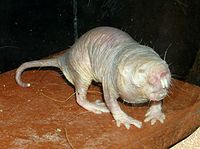
Photo from wikipedia
Over the previous several decades, many non-traditional research models have offered new avenues of exploration for biomedical research. The promise of these animals is primarily derived from adaptations to unique… Click to show full abstract
Over the previous several decades, many non-traditional research models have offered new avenues of exploration for biomedical research. The promise of these animals is primarily derived from adaptations to unique or challenging environments that share key factors with disease or pathology (e.g., hypoxemia or hypercarbia are in vivo consequences of environmental hypoxia and hypercapnia, respectively). Animals adapted to such environments allow us to ask the question: how has nature solved a particular problem and what can we learn to inform novel translational research into the treatment of related diseases and pathologies? One of the most promising mammalian models that have garnered increasing attention from researchers and the public are naked mole-rats (NMRs). The NMR is a small and eusocial subterranean rodent species that live in a putatively hypoxic and hypercapnic burrow environment. Intriguingly, whereas most non-traditional biomedical models offer insight into one or only a few diseases related to a common physiological stress, NMRs in contrast have proven to be resistant to a very wide range of ailments, including aging, cancer, and hypoxia- and hypercapnia-related disorders, among many others. In the present commentary, we discuss progress made in understanding how NMRs overcome these challenges and speculate on the origins of their remarkable abilities.
Journal Title: Comparative biochemistry and physiology. Part A, Molecular & integrative physiology
Year Published: 2022
Link to full text (if available)
Share on Social Media: Sign Up to like & get
recommendations!